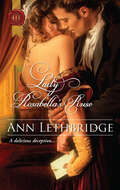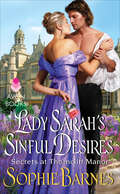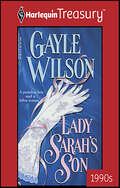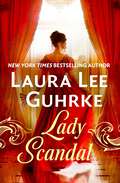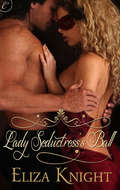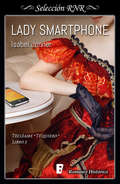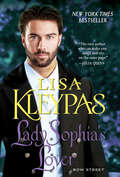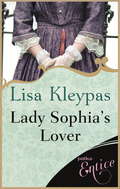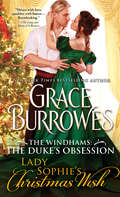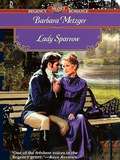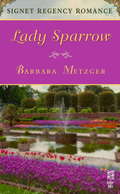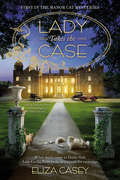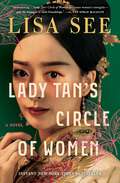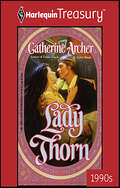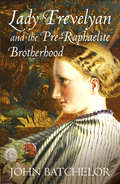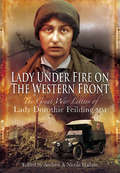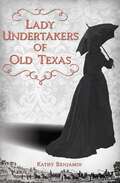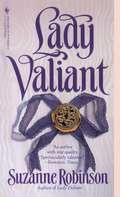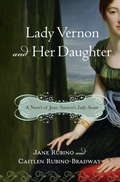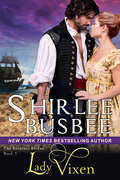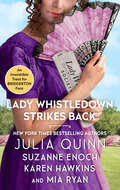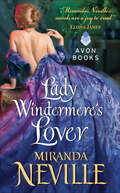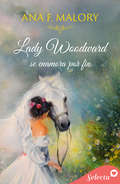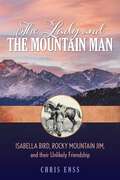- Table View
- List View
Lady Rosabella's Ruse (Rakes And Rascals Ser. #2)
by Ann LethbridgeA rakish baron may provide a scandalous solution for a young widow in search of an inheritance in this sexy Georgian Era romance.When Garth Evernden, eighth Baron Stanford, attends an “anything goes” house party, none of the women in attendance catch his jaded eye. The only one worth noting is a covered-up lady’s companion with an intriguing hint of exotic beauty the baron would like to uncover . . .Rose is in fact posing as a widow to find her inheritance—without it, she and her sisters will surely perish. Knowing that the handsome baron is reputed for his generosity, Rose concocts a new solution to her pressing dilemma. Surely becoming mistress to this rake would bring material advantages . . .
Lady Sackville: A Biography
by Susan Mary Alsop[from inside flaps] ""Quel roman est ma vie!" was one of Lady Victoria Sackville's frequent exclamations. The accuracy of the phrase--had she been able to see her life story written out as it is in this charming and delightful biography--would have pleased her and doubtless prompted the observation yet again, "My life is just like a novel!" And few upper-class young Englishwomen have ever had more reason to say so. Born in 1862, she was the illegitimate daughter of Pépita, the Spanish dancer, and Lionel Sackville-West, the distinguished British diplomat. Part of the fascination of her story is how that irregular birth affected her life and how she learned to triumph over its liabilities and skillfully manipulate its assets to her advantage. "It was," as Nigel Nicolson (Victoria's grandson) says, "an astonishing life." Her father was named British Minister to the United States, and as his hostess Victoria became the most popular girl in the American capital. As wife of her cousin, also named Lionel Sackville-West, she became mistress of Knole, one of the largest of the stately homes of England. As a high-living adventuress, she was the object of two bizarre lawsuits, one of them to prove her illegitimacy--ironically thereby preserving Knole and the Sackville title for her husband. She enchanted the major artistic and political figures of her time, and her story will fascinate readers today as her personality fascinated, and sometimes shocked, her own generation. This biography completes a trilogy, begun by Vita Sackville-West's Pépita (the life of her grandmother, the Spanish dancer) and continued by Portrait of a Marriage, in which Nigel Nicolson re-created the story of his parents, Vita and Harold Nicolson. Lady Sackville bridges the space between those two books, one by her daughter, the other by her grandson, to complete the picture of three generations of an ancient, noble, and gifted family. Susan Mary Alsop's previous book was To Marietta from Paris. Mrs. Alsop lives in Washington D.C."
Lady Sarah's Sinful Desires: Secrets at Thorncliff Manor (Secrets At Thorncliff Manor Ser.)
by Sophie BarnesThe USA Today–bestselling author welcomes you to Thorncliff Manor, where London’s elite mix, mingle, and may even find their heart’s desire . . .There are thousands of things Christopher, Viscount Spencer, would rather do than hunt for a bride, especially since experience has taught him that women are not to be trusted. Then he finds the intriguing Lady Sarah scrambling around in Thorncliff’s conservatory and he is instantly charmed by her passionate nature. But why is she so intent on avoiding him?Lady Sarah would make the perfect bride for a peer—if not for a tarnished past that she’s hiding from the ton. A stay at Thorncliff Manor was meant to help her plan for her future, not fall in love. Yet Christopher’s kisses are irresistible, his gallantry enticing. When her secret stands to be revealed, will the truth ruin their dreams of happiness?
Lady Sarah's Son
by Gayle WilsonJustin Tolbert was a war hero and the new Earl of Wynfield, but he was not the same man Lady Sarah Spense once knew....Suddenly, too vividly, Sarah remembered the night he had first asked her to dance. The London ballroom had been overcrowded, its heat stifling. Justin had been wearing his uniform, the handsome regimentals setting off the perfection of his strong body and his still-boyish face. She had thought then that there was no man more handsome in the room. She had stepped willingly into his arms, and when the music had begun, she had drifted, following his lead. They had moved together without conscious thought. As if the two of them had been created to dance together....Would they ever do that again...?Don't miss Gayle Wilson's extraordinary tale!
Lady Scandal (Scandal at the Savoy)
by Laura Lee GuhrkeFrom a New York Times bestselling author comes a dazzling Victorian romance featuring a haughty businessman and the headstrong event planner who steals his heart—perfect for fans of Bridgerton, Evie Dunmore, and Amalie Howard! Delia Stratham is an unconventional woman. While other ladies learned proper decorum at finishing school, she composed naughty limericks and admired the gardener&’s muscular legs. So naturally when she&’s widowed for the third time, she does the unthinkable: she gets a job. Planning events for the Savoy Hotel is perfect for someone with her skills. But her dream career turns into a nightmare when she&’s forced to work with the most annoying—and gorgeous—man she&’s ever met. Hotel magnate Simon Hayden knows something fishy is going on at the Savoy: the hotel is constantly busy, yet the books say it&’s in the red. He&’s determined to root out the fraud and its perpetrators, and that means spending time with one of the most likely suspects: the delectable, infuriating Lady Stratham. She&’s definitely getting in his way and under his skin and he can&’t decide whether to fire her or kiss her until she stops arguing. But when the sparks between them flare into flame, Simon must choose between his love for Delia and his duty to the hotel. Will his choice bring them together or tear them apart?
Lady Seductress's Ball
by Eliza KnightInvitation to PleasureAs the wife of the elderly Earl of March, Olivia Covington has never known the intimacies of the bedroom. Though her curiosity is piqued by the shocking whispers of society ladies, she is too wary of causing scandal to indulge in an affair. But Tristan Knightley, Earl of Newcastle, tempts her to throw off propriety. Tristan wants Olivia for his own, and has sworn off all others until he can rid himself of the obsession. He is sure once he has a taste, he will tire of her, and can return to his rakish existence. Unable to wait to have her in his bed, he invites her for a tryst at Lady Seductress's Ball... 24,000 words
Lady Smartphone (Serie Tecléame te quiero #Volumen 3)
by Isabel JennerUna escandalosa fotografía. Una dama en apuros. Y el hombre que menos se esperaba, dispuesto a salvarla de las garras de Internet en pleno siglo XIX. Flossie Easter es una joven dama londinense que disfruta de los placeres propios de su edad a través de las nuevas tecnologías. Lo que nunca habría imaginado es que un comprometedor selfie conseguirá que su ordenado mundo cambie en un solo día, y que el caballero del que una vez estuvo profundamente enamorada vuelva a aparecer a su lado. Lady Smartphon es la versión revisada y ampliada, con nuevas sorpresas para los lectores, del relato con el mismo nombre que la autora publicó en Internet y que tras el apabullante éxito obtenido dio comienzo a la serie «Tecléame te quiero». Todas las novelas de la serie pueden leerse y disfrutarse de forma independiente.
Lady Sophia's Lover (Bow Street #2)
by Lisa KleypasWhy is Lady Sophia looking for a lover?Andcould she seduce the most marriageable man in London? Lady Sophia Sydney would do anything to ensnare the unattainable Sir Ross Cannon. Her goal--to ruin his reputation and cause a scandal that would be the talk of all London. So she insinuates herself into his life by gaining his trust and living in his house. Every morning, her lush presence tempts him beyond all reason...the way she bends over the table to serve him the meals she has prepared...the way her hands oh, so gently--yet sensuously--brush against him. Every night, she promises with her eyes--and her body-- that the hours before dawn could be spent in unbridled passion instead of restless sleep--if only he'd let her share his bed. She knows he is falling more in love with her each day. But she never counted on falling in love with him. And she never dreamed he might very respectably ask for her hand in marriage... Are you ready to be seduced by New York Times Bestselling author Lisa Kleypas and her most compelling love story yet?
Lady Sophia's Lover (Bow Street Runners #2)
by Lisa KleypasThe second novel in the sensational Bow Street series from New York Times bestselling historical romance author Lisa Kleypas - perfect for fans of Sarah MacLean, Julia Quinn and Eloisa James. 'Lisa Kleypas is the best' Sarah MacLean Can Lady Sophie seduce the most eligible man in London? Lady Sophia Sydney would do anything to ensnare the unattainable Sir Ross Cannon. Her goal is to ruin his reputation and cause a scandal that would be the talk of all London. So, she charms her way into his life by gaining his trust and living in his house. Every morning, her lush presence tempts him beyond all reason and every night she promises with her eyes - and her body - that the hours before dawn could be spent in unbridled passion instead of restless sleep - if only he'd let her share his bed. She knows he is falling more in love with her each day. But she never counted on falling in love with him. And she never dreamed he might, very respectably, ask for her hand in marriage . . . 'Kleypas can make you laugh and cry - on the same page' Julia Quinn Bow Street Runners series: Someone to Watch Over Me Lady Sophia's Lover Worth Any Price Praise for Lisa Kleypas: 'Intricately and elegantly crafted, intensely romantic . . . a not-to-be-missed romance author' Kirkus Reviews 'Is it possible to give a book 6 stars? [This] story has all of the forbidden romance, witty banter, and sigh-inducing declarations of love that you deserve' That's Normal 'Kleypas is an amazing writer. In my opinion, she might be the most technically skilled historical romance author out there' Smart Bitches, Trashy Books 'Unforgettable, beautifully etched characters; a flawless sense of pacing; and a perfectly executed plot imbued with an abundance of desire and danger' Booklist 'Witty, often hilarious, and delightfully passionate, this compelling, thrill-laced Victorian romance is another superb series entry' Library Journal, starred review 'Readers are introduced to the unforgettable characters and their original personalities through a delightful storyline peppered with sharp repartee and steamy sensuality' RT Book Reviews (top pick) 'Reading Kleypas' long-awaited return to historical is akin to walking into the arms of an old friend' Heroes and Heartbreakers
Lady Sophie's Christmas Wish (The Windhams: The Duke's Daughters #1)
by Grace BurrowesGrace Burrowes makes Christmas wishes come true in this dazzling yuletide Regency romance where getting snowed-in at the family estate is the perfect way for Lady Sophie to rekindle the desire she thought she'd cast aside.All she wants is a little peace, but Sophie's holiday is about to heat up…Lady Sophie Windham has maneuvered a few days to herself at the ducal mansion in London before she must join her family for Christmas in Kent—her last chance for some peace and quiet before the holidays. Suddenly trapped in Town by a snowstorm, she finds herself with an abandoned baby and only the assistance of a kind, handsome stranger standing between her and complete disaster.With his estate in ruins, Vim Charpentier expected complications this holiday season, but he couldn't have predicted that Sophie Windham would be among them. His growing attraction for Sophie is the only thing that warms his spirits. But Sophie's been keeping secrets, and it will take more than a kiss under the mistletoe to make her wishes come true…
Lady Sparrow
by Barbara MetzgerFrom one of the shining stars of Signet Regency Romance comes Barbara Metzger’s engaging tale of scandals and secrets, and the risks of romance. Heiress Minerva Caldwell is alarmed to find that her late husband had a lot to hide—including a slew of affairs and a dozen illegitimate children! With the help of handsome Lord Lowell, she vows to find the by-blows and help them, should they be living in poverty. But she soon makes a startling discovery about her own past that could put her life—and, most certainly, her heart—at risk. When it’s Barbara Metzger, it’s “Regency romance at its finest and funniest.”
Lady Sparrow
by Barbara MetzgerFrom one of the shining stars of Signet Regency Romance comes Barbara Metzger's engaging tale of scandals and secrets, and the risks of romance.Heiress Minerva Caldwell is alarmed to find that her late husband had a lot to hide--including a slew of affairs and a dozen illegitimate children! With the help of handsome Lord Lowell, she vows to find the by-blows and help them, should they be living in poverty. But she soon makes a startling discovery about her own past that could put her life--and, most certainly, her heart--at risk.When it's Barbara Metzger, it's "Regency romance at its finest and funniest."-- Publishers Weekly
Lady Takes the Case (Manor Cat Mystery #1)
by Eliza CaseyWhen a dinner party turns deadly, the feisty Lady Cecilia Bates and intuitive cat Jack are on the case, in this first entry to an exciting new historical-mystery series.England 1912. Danby Hall is the only home Lady Cecilia Bates has ever known. Despite the rigid rules of etiquette and her mother the Countess of Avebury's fervent desire to see her married off, Lady Cecilia can't imagine life anywhere else. But now, with an agricultural depression sweeping the countryside, the Bates family's possession of the hall is suddenly in peril. A possible solution arrives in the form of the imperious American heiress Annabel Clarke. The Earl and Countess of Avebury are determined that Cecilia's brother, Patrick, will win Annabel's hand in marriage—and her fortune along with it. To help the lackluster Patrick in this pursuit, the Bates and their staff arrange a grand house party upon the heiress's arrival. When a guest dies after sipping from a glass meant for Annabel, it's clear the Bates have a more poisonous problem on their hands than a lack of chemistry. As the scandal seizes Danby, Cecilia sets out to find the culprit, with help from Annabel's maid, Jane, and Jane's curiously intelligent cat, Jack. After the poison that someone had stashed away inside the manor is discovered, Cecilia is left with two possibilities: Either a resident of Danby snapped and tried to kill the arrogant heiress, or the threat is coming from one of their guests, who would love to see the Bates family's decline become permanent.
Lady Tan's Circle of Women: A Novel
by Lisa See*NEW YORK TIMES BESTSELLER!* From &“one of those special writers capable of delivering both poetry and plot&” (The New York Times Book Review) an immersive historical novel inspired by the true story of a woman physician in 15th-century China—perfect for fans of Lisa See&’s classics Snow Flower and the Secret Fan and The Tea Girl of Hummingbird Lane.According to Confucius, &“an educated woman is a worthless woman,&” but Tan Yunxian—born into an elite family, yet haunted by death, separations, and loneliness—is being raised by her grandparents to be of use. Her grandmother is one of only a handful of female doctors in China, and she teaches Yunxian the pillars of Chinese medicine, the Four Examinations—looking, listening, touching, and asking—something a man can never do with a female patient. From a young age, Yunxian learns about women&’s illnesses, many of which relate to childbearing, alongside a young midwife-in-training, Meiling. The two girls find fast friendship and a mutual purpose—despite the prohibition that a doctor should never touch blood while a midwife comes in frequent contact with it—and they vow to be forever friends, sharing in each other&’s joys and struggles. No mud, no lotus, they tell themselves: from adversity beauty can bloom. But when Yunxian is sent into an arranged marriage, her mother-in-law forbids her from seeing Meiling and from helping the women and girls in the household. Yunxian is to act like a proper wife—embroider bound-foot slippers, recite poetry, give birth to sons, and stay forever within the walls of the family compound, the Garden of Fragrant Delights. How might a woman like Yunxian break free of these traditions and lead a life of such importance that many of her remedies are still used five centuries later? How might the power of friendship support or complicate these efforts? A captivating story of women helping each other, Lady Tan&’s Circle of Women is a triumphant reimagining of the life of one person who was remarkable in the Ming dynasty and would be considered remarkable today.
Lady Thorn
by Catherine ArcherJed McBride Had Come To England In Search Of His Long-Lost Sonand instead found the heartfelt passion of the aristocratic Victoria Thorn. But the two came from different worlds, and his own sad history had proved that such an alliance was doomed from the start!Though descended from fabled lovers, Lady Victoria Thorn feared a legendary love would never be hers. Rather, society demanded she preserve her bloodline with a safe and suitable match. But how suitable would the ton deem Jedidiah McBride, an American seafaring man who had sailed his way into her unguarded heart?
Lady Trevelyan and the Pre-Raphaelite Brotherhood
by John BatchelorAn entertaining account of an extraordinary cultural and historical event: - the establishment by one highly intelligent woman of a salon of the arts in a beautiful country house in Northumberland. Wallington Hall was remote from the major centres of artistic activity, such as London and Edinburgh. Yet Pauline Trevelyan single handedly made it the focus of High Victorian cultural life. Among those she attracted into her orbit were Ruskin, Swinburne, the Brownings, the Rossettis (Dante Gabriel, Christina and William Michael), Carlyle, and Millais and other members of the Pre-Raphaelite Brotherhood.The penniless but clever daughter of a clergyman, Pauline Jermyn married an older man whom she met through a shared passion for geology. Sir Walter Trevelyan was a philanthropist, teetotal, vegetarian, pacificist ... and very rich. With his encouragement, she collected works of art and decorated Wallington Hall with a cycle of vast paintings on the history of Northumberland. She was a patron of the arts who provided a fostering environment for many of the geniuses of her day. After her death, Swinburne wept every time her name was mentioned.
Lady Under Fire on the Western Front: The Great War Letters of Lady Dorothie Feilding MM
by Andrew Hallam Nicola HallamWhen Britain went to war in 1914 many people rallied to the cause, determined to join the colors or be useful in some other way. Lady Dorothie Mary Evelyn Feilding was one of the latter. ‘Lady D spent almost three years on the Western Front in Belgium driving ambulances for the Munro Motor Ambulance Corps, an all-volunteer unit. During her time in Flanders her bravery was such that she received the Belgian Order of Leopold, the French Croix de Guerre and was the first woman to be awarded the British Military Medal. She wrote home to Newnham Paddox, near Rugby, almost daily. Her letters reflect the mundane, tragedy and horror of war and also the tensions of being a woman at the front contending with shells, gossip, funding, lice, vehicle maintenance and inconvenient marriage proposals. Though Dorothie was the daughter of an Earl and from a privileged upbringing she had an easy attitude that transcended social boundaries and that endeared her to all that she came in to contact with whether royalty or the ordinary fighting man.
Lady Undertakers of Old Texas (The History Press)
by Kathy BenjaminAuthor Kathy Benjamin accompanies the pioneering women of the Lone Star State's funeral business.The intimate task of caring for the dead had long fallen under women's sphere of responsibilities. But after the Civil War, the sudden popularity of embalming offered new financial opportunities to men who set up as undertakers, pushing women out of their traditional role. In Texas, from the 1880s to the 1930s, women slowly regained their place by the bier. Many worked while pregnant or raising children. Most shouldered the additional weight of personal tragedies and persistent sexism. All brought comfort to the bereaved in the isolation of the Texas frontier, kept its cities free of deadly disease and revolutionized an industry that was just coming into its own.
Lady Valiant (Ladies #4)
by Suzanne RobinsonDetermined to pay back Mary Queen of Scots for her kindness, Thea Hunt journeys to Scotland to warn the queen not to enter into a treacherous marriage but finds herself chased down by a golden-haired highwayman.
Lady Vernon and Her Daughter: A Novel of Jane Austen's Lady Susan
by Jane Rubino Caitlen Rubino-BradwayThis delightful interpretation of Jane Austen's novella "Lady Susan" is a treat for fans of literature's most beloved woman of letters.
Lady Vixen (The Reckless Brides #3)
by Shirlee BusbeeNothing can quench the urgent fires of love they were born to share, except one ruthless enemy, in Lady Vixen, a historical romance by Shirlee Busbee.—English High Seas to New Orleans Pirate Havens, 1808—Outwitting a ruthless plot against her life, Nicole Ashford flees her aristocratic England home on a privateer's ship bound for the luxurious pirate havens of New Orleans.Yet Nicole’s daring escape has plunged her into even graver peril… as the captive mistress to the notorious high-seas outlaw, Captain Saber. In the night hours, his savage passion makes her a woman. But it is his tender kisses that are plundering her soul.Nothing can seem to stop what has begun between them. Nothing will satiate the urgent fires of love they seem born to share.Nothing except Nicole’s cunning and ruthless enemy who refuses to let her go.Publisher Note: Shirlee Busbee's page-turning historical romance transports readers to a world of strong men, vibrant women, heart-stopping plot twists, and breathless passion that is not for the faint of heart.Don't miss these other titles from Shirlee Busbee:THE RECKLESS BRIDES, in series orderThe Spanish RoseGypsy LadyLady VixenTHE RELUCTANT BRIDES, in series orderA Heart for the TakingSwear by MoonlightWhile Passion SleepsTHE SOUTHERN WOMEN, in series orderThe Tiger LilyEach Time We LoveAt Long LastLove a Dark RiderTHE LOUISIANA LADIES, in series orderDeceive Not My HeartMidnight MasqueradeLove Be Mine
Lady Whistledown Strikes Back
by Suzanne Enoch Julia Quinn Karen Hawkins Mia RyanWho Stole Lady Neeley's Bracelet?Was it the fortune hunter, the gambler, the servant, or the rogue? All of London is abuzz with speculation, but it is clear that one of four couples is connected to the crime.Lady Whistledown's Society Papers, May 1816Julia Quinn enchants: A dashing fortune hunter is captivated by the Season's most desired debutante . . . and must prove he is out to steal the lady's heart, not her dowry.Suzanne Enoch tantalizes: An innocent miss who has spent her life scrupulously avoiding scandal is suddenly--and secretly--courted by London's most notorious rogue.Karen Hawkins seduces: A roving viscount comes home to rekindle the passionate fires of his marriage . . . only to discover that his beautiful, headstrong bride will not be so easily won.Mia Ryan delights: A lovely, free-spirited servant is dazzled by the romantic attentions of a charming earl . . . sparking a scandalous affair that could ruin them both.You'll hear it first from Lady Whistledown
Lady Windermere's Lover (The Wild Quartet #3)
by Miranda NevilleIn Miranda Neville’s Regency romance Lady Windermere’s Lover, a rakish gambler risks everything to win the love of his estranged wife.Hell hath no fury . . . Damian, Earl of Windermere, rues the day he drunkenly gambled away his family’s estate and was forced into marriage to reclaim it. Now, after hiding out from his new bride for a year, Damian is finally called home, only to discover that his modest bride has become an alluring beauty—and rumor has it that she’s taken a lover. Damian vows to keep his wife from straying again, but to do so he must seduce her—and protect his heart from falling for the wife he never knew he wanted.Lady Cynthia never aspired to be the subject of scandal. But with her husband off gallivanting across Persia, what was a lady to do? Flirting shamelessly with his former best friend seemed like the perfect revenge . . . except no matter how little Damian deserves her loyalty, Cynthia can’t bring herself to be unfaithful. But now that the scoundrel has returned home, Cynthia isn’t about to forgive his absence so easily—even if his presence stirs something in her she’d long thought dead and buried. He might win her heart . . . if he can earn her forgiveness!“A smart, witty and emotionally dense love story that explores friendship and trust along its passionate and compelling journey.” —Kirkus ReviewsThe Wild QuartetThe Importance of Begin WickedThe Ruin of a RogueLady Windermere’s LoverThe Duke of Dark Desires
Lady Woodward se enamora por fin
by Ana F. MaloryOtra intensa y apasionante historia de amor de la autora de la exitosa novela A un beso del pasado. Incluso la más férrea determinación decae si la proposición es adecuada. La honorable señorita Alison Chambers, hija menor del barón y la baronesa Pemberton, siempre ha sido una joven alegre, extrovertida y de firmes convicciones que, por encima de todo, valora su libertad y tiene el solemne propósito de conservarla; no necesita un esposo para ser feliz. Su madre comienza a perder la esperanza de que acceda a casarse por voluntad propia y ya se la imagina convertida en una solterona que pasará el tiempo en el establo, rodeada de caballos. Brecc Hardwick, vecino y amigo inseparable de los hermanos Chambers, ha pasado de compartir juegos y travesuras con ellos a enamorarse de Alison. La conoce bien y sabe que debe tener paciencia y esperar el momento oportuno para hablarle de sus sentimientos y pedirle matrimonio, de lo contrario correría la misma suerte que el resto: sería rechazado. Por tanto, pretende conquistarla poco a poco, sin precipitar las cosas ni presionarla. La aparición del carismático y bohemio conde de Woodward truncará los planes de Brecc que, impotente, verá como la mujer de la que lleva años enamorado acepta casarse con un hombre que, por edad, bien podría ser su padre.
Lady and the Mountain Man: Isabella Bird, Rocky Mountain Jim, and their Unlikely Friendship
by Chris Enss**2022 Will Rogers Medallion Award Gold Winner for Western Biographies and Memoirs**The love they shared for an untamed land brought them together. Isabella Bird was a proper Victorian lady, a minster&’s daughter, a writer who traveled the globe. She was expected to marry a man of means and position instead she was drawn to a gruff mountain man, a desperado named Jim Nugent.The unlikely pair met in Estes Park, Colorado in 1873. Jim was enchanted by Isabella and she was infatuated with him. In a published version of Isabella&’s letter to her sister, she said of Jim that &“he was a man any woman might love but no sane woman would marry.&” On a climb to the top of Longs Peak their friendship blossomed into more than expected.This book reveals the true story of Bird&’s relationship with Nugent as they traveled through the dramatic wilderness of the Rocky Mountains.
